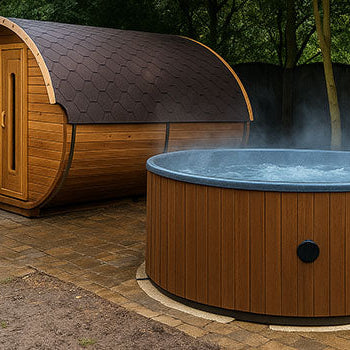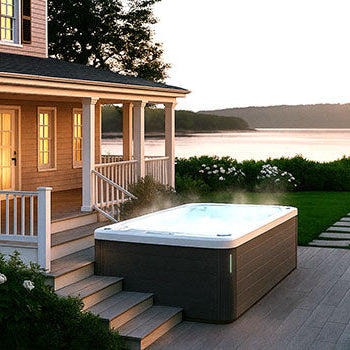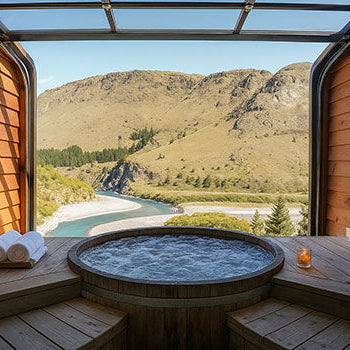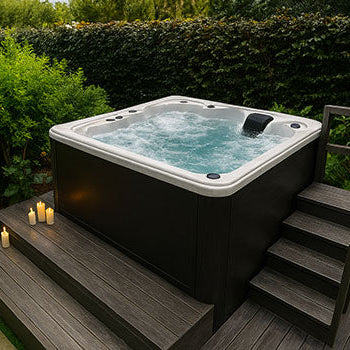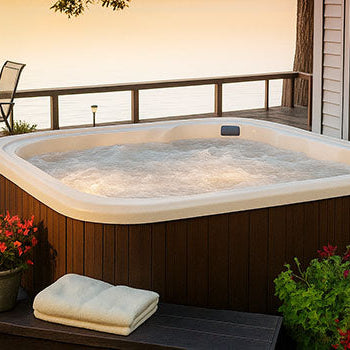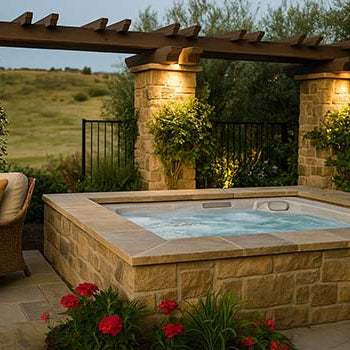Do wood fired hot tubs work? Yes, just add logs, light the fire, and wait for the magic. Whether you're into stylish acrylic tubs, rugged rotomoulded models, or classic wooden ones, there’s something deeply satisfying about heating water the old-fashioned way. It’s not just about warmth; it’s about experience.
You’ll soon see why people are ditching cables for kindling. If you like nature, saving money, and a bit of firecraft, this one’s for you.

Understanding the Basics: What is a Wood Fired Hot Tub?
Picture this: you're in your garden, the sun’s going down, and steam is rising from a tub warmed entirely by fire. That’s the essence of a wood fired hot tub. No buzzing pumps. No flashing lights. Just water, wood, and warmth.
They’ve become a hit in the UK for their off-grid simplicity and eco-friendly charm. Think of it as your very own spa retreat, minus the power bill.
Key Components: Tub, Stove (Internal/External), Chimney
Every setup includes:
-
A tub (made from materials like wood, acrylic, or rotomoulded plastic)
-
A wood-burning stove, either inside the tub or externally connected
-
A chimney to funnel the smoke upward and away
That’s it. No wires. No plug sockets. Just pure function and form.
The Off-Grid Heating Concept (No Electricity Required for Heating)
You won’t need to run an extension cord across the garden. These tubs run on firewood alone. Perfect for countryside cabins, forest glampsites, or just folks who like their tech with a bit of bark.
It’s as unplugged as a soak can get.
How Does the Wood Burner Heat the Water?
If you’ve ever boiled water in a kettle over a fire, you already understand the basic idea. Fire heats metal. Metal heats water. The result? A perfectly toasty tub.
Internal Submersible Stoves: Direct Heat Transfer Explained
These stoves are placed right in the tub water. When the fire burns inside them, the metal gets hot and transfers that heat directly to the water around it.
It’s incredibly efficient, and you’ll feel the temperature rise pretty quickly. Just make sure not to bump your toes on the stove while soaking!
External Stoves: Circulation Methods (Thermosiphon or Pump)
External stoves work a bit differently. As the fire heats the water inside the stove, the warm water naturally rises and circulates into the tub through the thermosiphon effect. Cooler water flows back into the stove, and the cycle continues.
No pump needed, although some setups include one to speed up the process.
The Science of Heat Transfer: Convection and Conduction
Here’s the science part, but we’ll keep it simple. Conduction is heat moving through solid metal. Convection is warm water moving through cooler water. Together, they create a natural and steady warming process, powered only by fire and gravity.

Heating Performance: How Effective Are They?
Let’s get real, are wood fired hot tubs as effective as electric ones?
Yes, and in some cases, even better. With the right setup, they can deliver powerful performance, unique charm, and impressive heat retention.
Typical Heating Times from Cold (Can Vary Significantly)
Starting from cold, most wood fired hot tubs take about 2 to 3 hours to reach soaking temperature. Smaller tubs heat up more quickly, while larger models or winter weather can stretch the wait.
Think of it like slow-cooking a stew, it takes time, but the result is worth it.
Factors Influencing Heating Speed (Stove Power, Wood, Volume, UK Temperatures)
Several factors affect how fast your tub heats up:
-
Stove size and design
-
Quality and dryness of the wood (dry hardwoods like ash or oak are best)
-
Water volume in the tub
-
Outdoor temperature, especially during cold UK winters
Using damp or softwood? Expect more smoke, less heat, and a longer wait.
Achieving and Maintaining Your Ideal Temperature
Most people aim for a water temperature of 38–40°C. Once there, a well-insulated tub and quality cover will retain heat for several hours.
Toss in an extra log every now and then to keep things toasty without overheating.
Methods for Controlling Water Temperature (Fire Management, Water Mixing)
Managing the heat is part of the fun. Open the firebox to raise the temperature, or add cold water if things get too warm. Use a floating thermometer to keep track.
It’s a hands-on experience, but that’s half the charm.
The Advantages of a Wood Fired Hot Tub Experience in the UK (Pros)
Independence from Electricity for Heating
Off-grid? No problem. A wood fired hot tub doesn’t need power to heat. Whether you’re in the countryside or facing a power outage, you can still enjoy a warm soak anytime.
Potentially Lower Running Costs (Fuelled by Wood)
After the initial purchase, your fuel source could be as simple as seasoned logs from your garden or local supplier. No electric bills, just stack, light, soak, repeat.
The Unique Ambiance and Rustic Appeal
There’s nothing quite like it, the smell of wood smoke, the crackle of the fire, and steam swirling into the night air. It’s campfire vibes with spa-level comfort.
Can Offer Faster Initial Heating Than Low-Power Electric Models
Budget electric models can take hours to reach temperature. In contrast, a well-fed fire in a wood fired tub can heat smaller tubs much faster, especially in milder weather.
The Considerations and Challenges Involved (Cons)
Requires Time and Effort for Initial Heating
This isn’t a push-button spa. You’ll need to plan ahead, light the fire, and monitor it as the water warms.
Less spontaneity, more satisfaction.
Active Temperature Management Needed During Use
There’s no thermostat here. You’ll be in charge of managing the fire, monitoring the temperature, and adding cold water if needed.
It’s hands-on, but for many, it’s part of the enjoyment.
Sourcing, Seasoning, and Storing Suitable Firewood
You’ll need a steady supply of dry, seasoned hardwood. That means sourcing it in advance and storing it in a dry, ventilated area.
Skip this step, and you’ll likely be sitting in lukewarm disappointment.
Regular Stove Maintenance (Ash Removal, Chimney Cleaning)
Just like a wood burner, your stove needs regular care.
Empty ash after each use, and clean the chimney periodically to avoid build-up.
A few minutes of maintenance = hours of enjoyment.
Smoke Considerations and UK Smoke Control Areas
If you're in a UK smoke control area, you’ll need a DEFRA-approved stove to comply with regulations.
Ignoring this can result in fines, so it’s best to check with your local council beforehand.
Potential to Overheat Water if Not Carefully Managed
It’s easier than you think to overshoot your target temperature. Too much wood can quickly turn your tub into a boiling cauldron.
Keep cold water nearby and use a reliable thermometer to monitor things.
Practical Aspects for UK Wood Fired Hot Tub Owners
Safe Siting: Clearances for Stove and Chimney
Choose a flat, non-flammable surface like gravel, concrete, or reinforced decking.
Ensure there’s at least 1 metre of clearance around the stove and chimney.
And no, your wooden shed is not a safe spot.
Water Sanitation and Filtration Options
You can go chemical-free, but that means more frequent maintenance and water changes. Others opt for natural sanitisers or simple filtration systems.
Find a routine that suits your lifestyle, and keeps the water crystal clear.
Understanding and Complying with Local Smoke Regulations
Smoke rules vary across the UK, so check with your local council for guidance. Staying compliant means peace of mind, and no unexpected penalties.
Better safe than smoky.

Conclusion: Yes, Wood Fired Hot Tubs Work Effectively (With a Different Approach)
So, do wood fired hot tubs work?
Absolutely. They’re simple, natural, and incredibly satisfying, if you’re willing to put in a bit of effort.
They're not plug-and-play. They're more chop, light, and soak. But that’s what makes the experience special.
For those who enjoy slowing down, connecting with nature, and unplugging from the rush of modern life, a wood fired tub is more than a hot bath, it’s a ritual.
